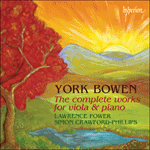Published by Swan & Co in 1923 and later reissued by Josef Weinberger, the
Melody for the G string was conceived for violin or viola playing in the same octave register. Accordingly it confines itself to darker hues and a modest range of pitch, its technical challenges arising from its key, G flat major. Assuming an accompanist of professional standing, Bowen is able to embellish and elevate a simple conceit by pianistic and harmonic means. The result is a gently affecting statement in ternary form and triple time, dominated by the rhythm presented in the violinist’s opening notes.
from notes by Francis Pott © 2013
Parue chez Swan & Co en 1923 puis republiée par Josef Weinberger, la
Mélodie pour la corde de sol fut conçue pour violon ou alto jouant dans le même registre d’octave. Elle se borne donc à des nuances sombres et à une modeste gamme de hauteurs de son, ses défis techniques découlant de son ton de sol bémol majeur. Misant sur un accompagnateur de niveau professionnel, Bowen peut embellir et exhausser un simple trait d’esprit avec des moyens pianistico-harmoniques. D’où une énonciation paisiblement touchante, de forme et de mesure ternaires, régie par le rythme présenté dans les notes liminaires, au violon.
extrait des notes rédigées par Francis Pott © 2013
Français: Hypérion
Die bei Swan & Co. 1923 erschienene und später von Josef Weinberger neuherausgegebene
Melody for the G string wurde für Geige oder Bratsche in der gleichen Oktavlage konzipiert. Entsprechend beschränkt sie sich auf dunklere Farben und einen bescheidenen Tonhöhenumfang, wobei sich die technischen Anforderungen aus der Tonart Ges-Dur ergeben. Bowen war vermutlich ein Begleiter von professionellem Rang und konnte daher einen einfachen Einfall durch pianistische und harmonische Mittel verzieren und aufwerten. Daraus ergibt sich eine sanft ergreifende Komposition in dreiteiliger Form und im Dreiertakt, in der der Rhythmus der Geigentöne am Anfang vorherrscht.
aus dem Begleittext von Francis Pott © 2013
Deutsch: Christiane Frobenius


 Bowen: The complete works for viola & piano
Bowen: The complete works for viola & piano
